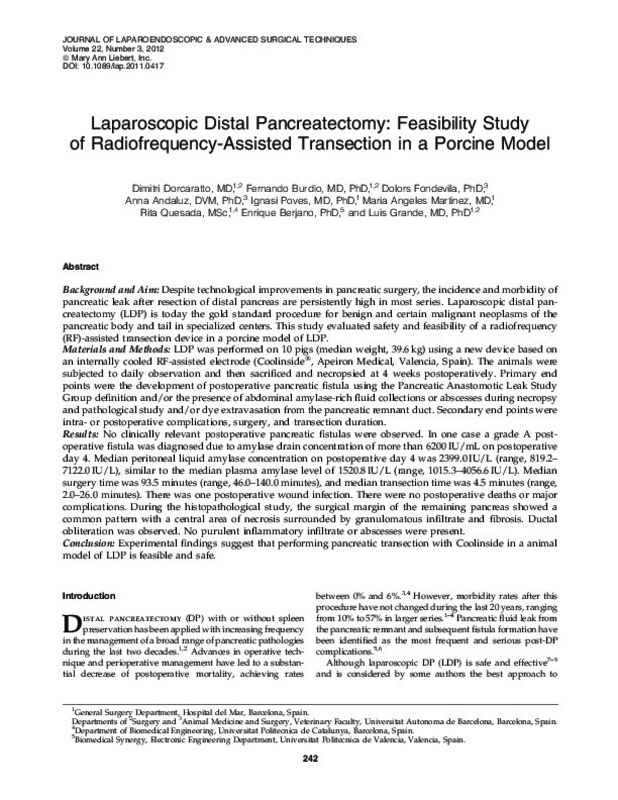JavaScript is disabled for your browser. Some features of this site may not work without it.
Buscar en RiuNet
Listar
Mi cuenta
Estadísticas
Ayuda RiuNet
Admin. UPV
Laparoscopic Distal Pancreatectomy: Feasibility Study of Radiofrequency-Assisted Transection in a Porcine Model
Mostrar el registro sencillo del ítem
Ficheros en el ítem
| dc.contributor.author | Dorcaratto, Dimitri
|
es_ES |
| dc.contributor.author | Burdio Pinilla, Fernando
|
es_ES |
| dc.contributor.author | Fondevila, Dolors
|
es_ES |
| dc.contributor.author | Andaluz, Anna
|
es_ES |
| dc.contributor.author | Poves, Ignasi
|
es_ES |
| dc.contributor.author | Martínez, María Ángeles
|
es_ES |
| dc.contributor.author | Quesada, Rita
|
es_ES |
| dc.contributor.author | Berjano Zanón, Enrique
|
es_ES |
| dc.contributor.author | Grande, Luis
|
es_ES |
| dc.date.accessioned | 2014-01-08T13:06:00Z | |
| dc.date.available | 2014-01-08T13:06:00Z | |
| dc.date.issued | 2012 | |
| dc.identifier.issn | 1092-6429 | |
| dc.identifier.uri | http://hdl.handle.net/10251/34814 | |
| dc.description | This is a copy of an article published in the Journal of Laparoendoscopic and Advanced Surgical Techniques © 2012 [copyright Mary Ann Liebert, Inc.]; Journal of Laparoendoscopic and Advanced Surgical Techniques is available online at: http://online.liebertpub.com. | es_ES |
| dc.description.abstract | Background and Aim: Despite technological improvements in pancreatic surgery, the incidence and morbidity of pancreatic leak after resection of distal pancreas are persistently high in most series. Laparoscopic distal pancreatectomy (LDP) is today the gold standard procedure for benign and certain malignant neoplasms of the pancreatic body and tail in specialized centers. This study evaluated safety and feasibility of a radiofrequency (RF)-assisted transection device in a porcine model of LDP. Materials and Methods: LDP was performed on 10 pigs (median weight, 39.6 kg) using a new device based on an internally cooled RF-assisted electrode (Coolinside (R), Apeiron Medical, Valencia, Spain). The animals were subjected to daily observation and then sacrificed and necropsied at 4 weeks postoperatively. Primary end points were the development of postoperative pancreatic fistula using the Pancreatic Anastomotic Leak Study Group definition and/or the presence of abdominal amylase-rich fluid collections or abscesses during necropsy and pathological study and/or dye extravasation from the pancreatic remnant duct. Secondary end points were intra- or postoperative complications, surgery, and transection duration. Results: No clinically relevant postoperative pancreatic fistulas were observed. In one case a grade A postoperative fistula was diagnosed due to amylase drain concentration of more than 6200 IU/mL on postoperative day 4. Median peritoneal liquid amylase concentration on postoperative day 4 was 2399.0 IU/L (range, 819.2-7122.0 IU/L), similar to the median plasma amylase level of 1520.8 IU/L (range, 1015.3-4056.6 IU/L). Median surgery time was 93.5 minutes (range, 46.0-140.0 minutes), and median transection time was 4.5 minutes (range, 2.0-26.0 minutes). There was one postoperative wound infection. There were no postoperative deaths or major complications. During the histopathological study, the surgical margin of the remaining pancreas showed a common pattern with a central area of necrosis surrounded by granulomatous infiltrate and fibrosis. Ductal obliteration was observed. No purulent inflammatory infiltrate or abscesses were present. Conclusion: Experimental findings suggest that performing pancreatic transection with Coolinside in a animal model of LDP is feasible and safe. | es_ES |
| dc.description.sponsorship | This work received financial support from the Spanish "Plan Nacional de I+D+I del Ministerio de Ciencia e Innovacion," grant number TEC2008-01369/TEC, and from the Generalitat Valenciana (Ayudas Complementarias de I+D para Grupos de Calidad ACOMP/2010/008). | en_EN |
| dc.language | Inglés | es_ES |
| dc.publisher | Mary Ann Liebert | es_ES |
| dc.relation.ispartof | Journal of Laparoendoscopic and Advanced Surgical Techniques | es_ES |
| dc.rights | Reserva de todos los derechos | es_ES |
| dc.subject | Bloodless rapid transection | es_ES |
| dc.subject | Risk-factors | es_ES |
| dc.subject | Pig-liver | es_ES |
| dc.subject | In-vivo | es_ES |
| dc.subject | Fistula | es_ES |
| dc.subject | Management | es_ES |
| dc.subject | Device | es_ES |
| dc.subject | Leak | es_ES |
| dc.subject | Experience | es_ES |
| dc.subject | Pancreas | es_ES |
| dc.subject.classification | TECNOLOGIA ELECTRONICA | es_ES |
| dc.title | Laparoscopic Distal Pancreatectomy: Feasibility Study of Radiofrequency-Assisted Transection in a Porcine Model | es_ES |
| dc.type | Artículo | es_ES |
| dc.identifier.doi | 10.1089/lap.2011.0417 | |
| dc.relation.projectID | info:eu-repo/grantAgreement/MICINN//TEC2008-01369/ES/MODELOS COMPUTACIONALES E INVESTIGACION EXPERIMENTAL EN EL ESTUDIO DE TECNICAS QUIRURGICAS DE CALENTAMIENTO DE TEJIDOS BIOLOGICOS MEDIANTE CORRIENTES DE RADIOFRECUENCIA./ | es_ES |
| dc.relation.projectID | info:eu-repo/grantAgreement/GVA//ACOMP%2F2010%2F008/ | es_ES |
| dc.rights.accessRights | Abierto | es_ES |
| dc.contributor.affiliation | Universitat Politècnica de València. Departamento de Ingeniería Electrónica - Departament d'Enginyeria Electrònica | es_ES |
| dc.description.bibliographicCitation | Dorcaratto, D.; Burdio Pinilla, F.; Fondevila, D.; Andaluz, A.; Poves, I.; Martínez, MÁ.; Quesada, R.... (2012). Laparoscopic Distal Pancreatectomy: Feasibility Study of Radiofrequency-Assisted Transection in a Porcine Model. Journal of Laparoendoscopic and Advanced Surgical Techniques. 22(3):242-248. https://doi.org/10.1089/lap.2011.0417 | es_ES |
| dc.description.accrualMethod | S | es_ES |
| dc.relation.publisherversion | http://dx.doi.org/10.1089/lap.2011.0417 | es_ES |
| dc.description.upvformatpinicio | 242 | es_ES |
| dc.description.upvformatpfin | 248 | es_ES |
| dc.type.version | info:eu-repo/semantics/publishedVersion | es_ES |
| dc.description.volume | 22 | es_ES |
| dc.description.issue | 3 | es_ES |
| dc.relation.senia | 235495 | |
| dc.identifier.eissn | 1557-9034 | |
| dc.contributor.funder | Ministerio de Ciencia e Innovación | es_ES |
| dc.contributor.funder | Generalitat Valenciana | es_ES |








